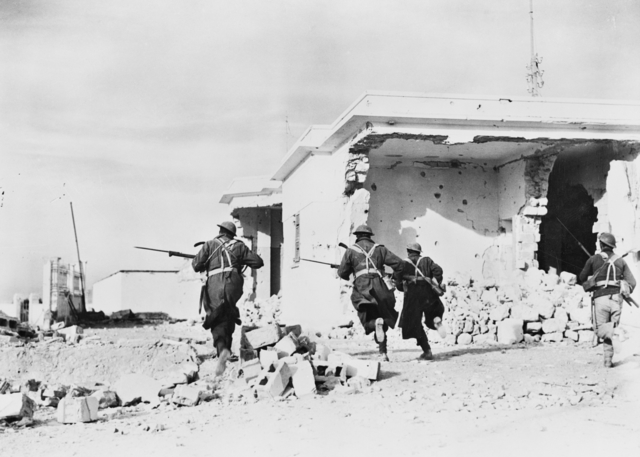|
11th Division (Australia)
The 11th Division was an Australian Army unit formed during World War II by the renaming of Milne Force in December 1942. Predominately a Militia formation, the division's main role during the war was as a base command headquarters, although elements saw action in New Guinea against Japanese forces during the Finisterre Range campaign and in New Britain. It was disbanded in July 1946. History In July 1942, a headquarters was raised to command the units that had been sent to Milne Bay, to establish a series of airfields there after the Battle of the Coral Sea. The majority of the staff for this headquarters came from the 1st Division, and at the time of its establishment it was called "C Force" and became Milne Force in August 1942. Only a limited number of troops were assigned, with the first elements being two companies of Militia troops from the 55th Battalion, bolstered later by the arrival of the 7th Infantry Brigade and then the 18th Infantry Brigade, a veteran Second A ... [...More Info...] [...Related Items...] OR: [Wikipedia] [Google] [Baidu] |
Australian Army
The Australian Army is the principal Army, land warfare force of Australia, a part of the Australian Defence Force (ADF) along with the Royal Australian Navy and the Royal Australian Air Force. The Army is commanded by the Chief of Army (Australia), Chief of Army (CA), who is subordinate to the Chief of the Defence Force (Australia), Chief of the Defence Force (CDF) who commands the ADF. The CA is also directly responsible to the Minister of Defence (Australia), Minister for Defence, with the Department of Defence (Australia), Department of Defence administering the ADF and the Army. Formed in 1901, as the Commonwealth Military Forces, through the amalgamation of the colonial forces of Australia following the Federation of Australia. Although Australian soldiers have been involved in a number of minor and major conflicts throughout Australia's history, only during the Second World War has Australian territory come under direct attack. The Australian Army was initially composed a ... [...More Info...] [...Related Items...] OR: [Wikipedia] [Google] [Baidu] |
55th Battalion (Australia)
The 55th Battalion was an infantry battalion of the Australian Army. Raised in 1916 for service during World War I in the AIF the battalion served on the Western Front until the end of the war, before being briefly amalgamated with the 53rd Battalion and then being disbanded in 1919. In 1921, the 55th Battalion (militia) was re-raised and in 1927 adopted the title of the "New South Wales Irish Rifles". This designation was later changed to the "New South Wales Rifle Regiment" in 1930, before they were once again amalgamated with the 53rd, forming the 55th/53rd Battalion (New South Wales Rifle/West Sydney Regiment) in 1937. In October 1941, during World War II, the two militia battalions were delinked and the 55th was later deployed to New Guinea, where they took part in the Kokoda Track campaign, fighting against the Japanese. Poorly prepared and trained, and lacking up to date equipment, they performed above expectations; however, they were amalgamated with the 53rd, which had ... [...More Info...] [...Related Items...] OR: [Wikipedia] [Google] [Baidu] |
6th Brigade (Australia)
The 6th Combat Support Brigade is an Australian Army brigade. First formed in 1912 as a Militia formation to provide training under the compulsory training scheme, the brigade was re-raised during the First World War as an infantry unit of the all volunteer Australian Imperial Force. It subsequently served at Gallipoli and in France and Belgium on the Western Front. In the 1920s, as part of a reorganisation of the Australian Army, it became part of the 3rd Military District of the Citizens Military Force, encompassing units from Victoria and South Australia. In 1991, it became part of the Ready Reserve Scheme, based at Enoggera Barracks, in Brisbane, Queensland, before being disbanded in 1996 when the scheme was discontinued. The brigade was re-raised on 1 March 2010 to oversee the Army's command support and intelligence, surveillance, target acquisition and reconnaissance (CS & ISTAR) units. History The 6th Brigade traces its origins to 1912, when it was formed as a Militi ... [...More Info...] [...Related Items...] OR: [Wikipedia] [Google] [Baidu] |
41st Infantry Division (United States)
The 41st Infantry Division was an infantry division of the United States Army National Guard composed primarily of units from the Pacific Northwest. The division saw active service in World War I and World War II., receiving the nickname Jungleers during the latter. Organized in 1917 after the American entry into World War I, the division was selected as a replacement division after being deployed to France as part of the American Expeditionary Forces. Its infantry units were used to provide individual replacements and the division functioned as a replacement depot. The 41st Division was reorganized in the National Guard during the interwar period, consisting of units from Oregon, Washington, Montana, Idaho and Wyoming. Sent to Australia after the Attack on Pearl Harbor, the 41st became one of the first Army units to engage in offensive ground combat operations during World War II when elements of the division were committed to the New Guinea campaign in the last months of ... [...More Info...] [...Related Items...] OR: [Wikipedia] [Google] [Baidu] |
6th Division (Australia)
The 6th Division was an infantry Division (military), division of the Australian Army. It was raised briefly in 1917 during World War I, but was broken up to provide reinforcements before seeing action. It was not re-raised until the outbreak of World War II, when it was formed as a unit of the Second Australian Imperial Force (2nd AIF). Throughout 1940–41 it served in the North African Campaign, the Battle of Greece, Greek campaign, on Battle of Crete, Crete and in Syria-Lebanon campaign, Syria, fighting against the Germans, Italians and Vichy French. In 1942, the division left the Mediterranean and Middle East theatre of World War II, Middle East and returned to Australia to meet the threat of Japan's entry into the war. Part of the division garrisoned Ceylon for a short period of time, before the division was committed to the New Guinea campaign. In New Guinea, its component brigades had a major role in the successful counter-offensive along the Kokoda Track Campaign, Kokoda ... [...More Info...] [...Related Items...] OR: [Wikipedia] [Google] [Baidu] |
Port Moresby
(; Tok Pisin: ''Pot Mosbi''), also referred to as Pom City or simply Moresby, is the capital and largest city of Papua New Guinea. It is one of the largest cities in the southwestern Pacific (along with Jayapura) outside of Australia and New Zealand. It is located on the shores of the Gulf of Papua, on the south-western coast of the Papuan Peninsula of the island of New Guinea. The city emerged as a trade centre in the second half of the 19th century. During World War II, it was a prime objective for conquest by the Imperial Japanese forces during 1942–43 as a staging point and air base to cut off Australia from Southeast Asia and the Americas. As of the 2011 census, Port Moresby had 364,145 inhabitants. An unofficial 2020 estimate gives the population as 383,000. The place where the city was founded has been inhabited by the Motu-Koitabu people for centuries. The first Briton to see it was Royal Navy Captain John Moresby in 1873. It was named in honour of his father, A ... [...More Info...] [...Related Items...] OR: [Wikipedia] [Google] [Baidu] |
5th Division (Australia)
The 5th Division was an infantry Division (military), division of the Australian Army which served during the First World War, First and Second World Wars. The division was formed in February 1916 as part of the expansion of the First Australian Imperial Force, Australian Imperial Force infantry brigades. In addition to the existing 8th Brigade (Australia), 8th Brigade were added the new 14th Brigade (Australia), 14th and 15th Brigade (Australia), 15th Brigades, which had been raised from the battalions of the 1st Brigade (Australia), 1st and 2nd Brigade (Australia), 2nd Brigades respectively. From Egypt the division was sent to France and then Belgium, where they served in the trenches along the Western Front (World War I), Western Front until the end of the war in November 1918. After the war ended, the division was demobilised in 1919. The division was re-raised as a Australian Army Reserve, Militia formation during the Second World War, and was mobilised for the defence of ... [...More Info...] [...Related Items...] OR: [Wikipedia] [Google] [Baidu] |
Cyril Clowes
Lieutenant General Cyril Albert Clowes, (11 March 1892 – 19 May 1968) was an Australian soldier. He won the first land victory against the Japanese in the Second World War, at the Battle of Milne Bay, New Guinea. Like many other senior officers involved in the Papuan campaign, he was then transferred to a less important posting by General Sir Thomas Blamey. Early life and First World War Clowes was born at Warwick in Queensland, and entered the Royal Military College, Duntroon in 1911. In August 1914 he graduated and was appointed lieutenant in the Australian Imperial Force (AIF) with a commission in the Permanent Military Force. Posted to the 1st Field Artillery Brigade, he landed at Gallipoli on 25 April 1915, serving as a forward observation officer and directing naval gunfire against Turkish positions. He was wounded at Gallipoli. After he recuperated Clowes was promoted to captain in the 2nd Divisional Artillery in Egypt during January 1916. On the Western Front dur ... [...More Info...] [...Related Items...] OR: [Wikipedia] [Google] [Baidu] |
Major-General
Major general (abbreviated MG, maj. gen. and similar) is a military rank used in many countries. It is derived from the older rank of sergeant major general. The disappearance of the "sergeant" in the title explains the apparent confusion of a lieutenant general outranking a major general, whereas a major outranks a lieutenant. In the Commonwealth and in the United States, when appointed to a field command, a major general is typically in command of a division consisting of around 6,000 to 25,000 troops (several regiments or brigades). It is a two-star rank that is subordinate to the rank of lieutenant general and senior to the rank of brigadier or brigadier general. In the Commonwealth, major general is equivalent to the navy rank of rear admiral. In air forces with a separate rank structure (Commonwealth), major general is equivalent to air vice-marshal. In some countries including much of Eastern Europe, major general is the lowest of the general officer ranks, with no ... [...More Info...] [...Related Items...] OR: [Wikipedia] [Google] [Baidu] |
Battle Of Buna–Gona
The battle of Buna–Gona was part of the New Guinea campaign in the Pacific Theatre during World War II. It followed the conclusion of the Kokoda Track campaign and lasted from 16 November 1942 until 22 January 1943. The battle was fought by Australian and United States forces against the Japanese beachheads at Buna, Sanananda and Gona. From these, the Japanese had launched an overland attack on Port Moresby. In light of developments in the Solomon Islands campaign, Japanese forces approaching Port Moresby were ordered to withdraw to and secure these bases on the northern coast. Australian forces maintained contact as the Japanese conducted a well-ordered rearguard action. The Allied objective was to eject the Japanese forces from these positions and deny them their further use. The Japanese forces were skillful, well prepared and resolute in their defence. They had developed a strong network of well-concealed defences. Operations in Papua and New Guinea were severely ha ... [...More Info...] [...Related Items...] OR: [Wikipedia] [Google] [Baidu] |
17th Brigade (Australia)
The 17th Brigade was an infantry brigade in the Australian Army. First raised in 1912 as a Militia formation to provide training under the compulsory training scheme, the brigade was later re-raised as part of the First Australian Imperial Force during World War I. Established in 1917 in the United Kingdom, it was broken up and disbanded without seeing action, and its personnel used as reinforcements for other formations. Reformed during World War II, it took part in fighting in Libya, Greece, Crete, Syria in 1941–1942. Following Japan's entry into the war, the Australian government pressed for the 6th Division's return, and the 17th Brigade was subsequently brought back from the Middle East, via Ceylon where they undertook defensive duties until July 1942. Following the brigade's return to Australia, it was deployed to New Guinea for two campaigns: the Salamaua–Lae campaign in 1943 and the Aitape–Wewak campaign in 1944–1945. After the war, the brigade was disbanded in ... [...More Info...] [...Related Items...] OR: [Wikipedia] [Google] [Baidu] |
Battle Of Milne Bay
The Battle of Milne Bay (25 August – 7 September 1942), also known as Operation RE or the Battle of Rabi (ラビの戦い) by the Japanese, was a battle of the Pacific campaign of World War II. Japanese marines, known as ''Kaigun Tokubetsu Rikusentai'' (Special Naval Landing Forces), with two small tanks attacked the Allied airfields at Milne Bay that had been established on the eastern tip of New Guinea. Due to poor intelligence work, the Japanese miscalculated the size of the predominantly Australian garrison and, believing that the airfields were defended by only two or three companies, initially landed a force roughly equivalent in size to one battalion on 25 August 1942. The Allies, forewarned by intelligence from Ultra, had heavily reinforced the garrison. Despite suffering a significant setback at the outset, when part of their small invasion force had its landing craft destroyed by Royal Australian Air Force aircraft as they attempted to land on the coast behind t ... [...More Info...] [...Related Items...] OR: [Wikipedia] [Google] [Baidu] |







